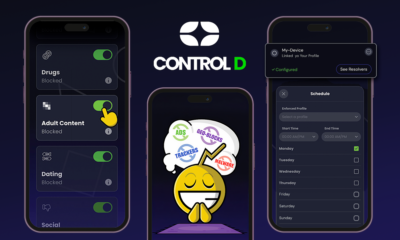TECHNOLOGY
Why is this Key Aspect Critical to Ensuring your Business Environment Thrives?

A Thorough Email Tracking Process: Why is this Key Aspect Critical to Ensuring your Business Environment Thrives?
Maybe you’ve heard of email marketing, maybe you’ve heard of the term email tracking, or you’re familiar with the idea of tracking clicks and opens, but haven’t yet understood how it works. But is email marketing the right way to leverage your business environment?
Mail tracking is nothing new and certainly not unusual. You should not be surprised to learn that the emails you receive from major media outlets and informational emails you subscribe to are being tracked, these processes are provided by email tracking services. According to recent studies by email companies, 99% of all email is bulk mail. Emails such as informational, and marketing emails are carefully monitored. This is why email tracking is effective in helping businesses identify what content customers are responding to. The collection of data such as clicks, time spent on the site, opening of an informative marketing email, and purchases is invaluable. The value of email tracking lies in the data it provides. This marketing data can help answer important questions that will allow you to understand how to promote your brand and what marketing strategy to choose to actively grow your business.

Did You Get my Email?
If you send a follow-up email, you don’t need to ask this question again. Email tracking allows senders to see who opened an email and when. Over time, you will be able to determine who is most active on your mailing list and what content is worth including. It’s even better to know who opens your email and who clicks on the links it contains. You can reach important customers and save time. If you see the same person reading about saving money, mortgage rates, and home-buying trends, it might be time to check if that person is in the market. This brings us to the next important point.
Reaching the Most Relevant Potential Customers
If your time is limited (for example, every day), you need to use it wisely. One of the key ways to do this is to reach only the most qualified and relevant leads, potential partners. When someone has opened your email 5 times and clicked the download link twice in the last 48 hours, they can call you. With these tips, you’ll know who’s ready to take the next step in the sales cycle.
How Did You Meet us?
Referrals play a key role in the success of your business environment. Many consumers spend a lot of time gathering, painstakingly researching, and comparing all available information before successfully making their purchase. Vouching for current and potential customers, you will be able to stand out from the competition. By sending emails to people on your list, you can easily get your content out to potential customers. According to research, 80% of consumers ask for advice from relatives and friends before making a purchase. Emails play a key role in your success because they give buyers confidence that they can reach you promptly. It is not always possible to please everyone. This is as true in life as it is in emails and mail marketing. More than 60% of consumers prefer brands that provide email communication. However, there are still those who do not do this. The order will be canceled, but what happens after that is key. When you see an increase in orders after sending an email, keep an eye out for updates:
Did you miss a broken link?
Is the header content separated?
Did you change the email frequency?
It could be one of these reasons, but it could also be another. Either way, use the opt-out option to learn more about what your audience doesn’t want to see.
Are Customers Interested in your Content?
Personal interactions via email are important, but it’s even more important to consider long-term interactions. Use the metrics provided by b2b website visitor identification software to see how your audience interacts with your content over months or even years. It’s easy to read an informational email, feel overwhelmed, and decide to change its format or design. However, analysis of long-term results often provides compelling evidence for decision-making. Track engagement over time and make changes when you’re confident you’re getting high and consistent results.
Email Tracking Can Significantly Help Businesses in their Active Development
Email tracking can help your business in many ways. Below is a short list of a few examples of how email tracking can be a valuable tool for your business. When you start an email marketing campaign, you can cast a wide net. But of course, some people may not be interested in your email and your great offers. With email tracking, you can quickly find out who opened your email and who didn’t. So please don’t send any more emails to people who aren’t interested in what you have to offer. Send emails to interested people who open your messages, save your sales team time by avoiding irrelevant people, and target people who are most interested in your content.
Create Creative Data-Driven Marketing Campaigns
Data-driven marketing campaigns allow you to develop smarter marketing tactics and strategies. With valuable insights and marketing data at your fingertips, you can determine the types of messages and offers that will most engage your audience. Email tracking helps you better understand your target audience and create better emails and more creative email campaigns. Build trusting relationships with your customers. Email tracking helps you better understand your recipients, their actual needs, and expectations by learning which emails they interact with. Email tracking tools help you create more personalized emails and run engaging email campaigns that result in more effective customer communication. Measurement result. To determine if your mailing is effective, you need to measure results. When you know who opens your emails and when you can personalize and improve your mailings. Email marketing campaigns are very effective when they are well thought out. For example, readers can open your email at a specific time. Using this information, you can ensure that emails from your email address are sent when your customers are most likely to see and open them. There are a variety of email tracking tools available, and many key email tracking features are integrated into modern CRM platforms.
Email tracking tools and key features can track activity in several ways. At its most basic level, email tracking works by adding a single pixel-masked image to outgoing emails. This pixel allows the server to notify you when a recipient opens an email. Email trackers don’t just report email opens, they also provide other valuable marketing information. For example, an email link in an email can be changed to a tracking URL that will notify the recipient when the link is followed. With the CRM platform’s available functionality, you can track and manage all your emails.
TECHNOLOGY
Next-gen chips, Amazon Q, and speedy S3

AWS re:Invent, which has been taking place from November 27 and runs to December 1, has had its usual plethora of announcements: a total of 21 at time of print.
Perhaps not surprisingly, given the huge potential impact of generative AI – ChatGPT officially turns one year old today – a lot of focus has been on the AI side for AWS’ announcements, including a major partnership inked with NVIDIA across infrastructure, software, and services.
Yet there has been plenty more announced at the Las Vegas jamboree besides. Here, CloudTech rounds up the best of the rest:
Next-generation chips
This was the other major AI-focused announcement at re:Invent: the launch of two new chips, AWS Graviton4 and AWS Trainium2, for training and running AI and machine learning (ML) models, among other customer workloads. Graviton4 shapes up against its predecessor with 30% better compute performance, 50% more cores and 75% more memory bandwidth, while Trainium2 delivers up to four times faster training than before and will be able to be deployed in EC2 UltraClusters of up to 100,000 chips.
The EC2 UltraClusters are designed to ‘deliver the highest performance, most energy efficient AI model training infrastructure in the cloud’, as AWS puts it. With it, customers will be able to train large language models in ‘a fraction of the time’, as well as double energy efficiency.
As ever, AWS offers customers who are already utilising these tools. Databricks, Epic and SAP are among the companies cited as using the new AWS-designed chips.
Zero-ETL integrations
AWS announced new Amazon Aurora PostgreSQL, Amazon DynamoDB, and Amazon Relational Database Services (Amazon RDS) for MySQL integrations with Amazon Redshift, AWS’ cloud data warehouse. The zero-ETL integrations – eliminating the need to build ETL (extract, transform, load) data pipelines – make it easier to connect and analyse transactional data across various relational and non-relational databases in Amazon Redshift.
A simple example of how zero-ETL functions can be seen is in a hypothetical company which stores transactional data – time of transaction, items bought, where the transaction occurred – in a relational database, but use another analytics tool to analyse data in a non-relational database. To connect it all up, companies would previously have to construct ETL data pipelines which are a time and money sink.
The latest integrations “build on AWS’s zero-ETL foundation… so customers can quickly and easily connect all of their data, no matter where it lives,” the company said.
Amazon S3 Express One Zone
AWS announced the general availability of Amazon S3 Express One Zone, a new storage class purpose-built for customers’ most frequently-accessed data. Data access speed is up to 10 times faster and request costs up to 50% lower than standard S3. Companies can also opt to collocate their Amazon S3 Express One Zone data in the same availability zone as their compute resources.
Companies and partners who are using Amazon S3 Express One Zone include ChaosSearch, Cloudera, and Pinterest.
Amazon Q
A new product, and an interesting pivot, again with generative AI at its core. Amazon Q was announced as a ‘new type of generative AI-powered assistant’ which can be tailored to a customer’s business. “Customers can get fast, relevant answers to pressing questions, generate content, and take actions – all informed by a customer’s information repositories, code, and enterprise systems,” AWS added. The service also can assist companies building on AWS, as well as companies using AWS applications for business intelligence, contact centres, and supply chain management.
Customers cited as early adopters include Accenture, BMW and Wunderkind.
Want to learn more about cybersecurity and the cloud from industry leaders? Check out Cyber Security & Cloud Expo taking place in Amsterdam, California, and London. Explore other upcoming enterprise technology events and webinars powered by TechForge here.
TECHNOLOGY
HCLTech and Cisco create collaborative hybrid workplaces

Digital comms specialist Cisco and global tech firm HCLTech have teamed up to launch Meeting-Rooms-as-a-Service (MRaaS).
Available on a subscription model, this solution modernises legacy meeting rooms and enables users to join meetings from any meeting solution provider using Webex devices.
The MRaaS solution helps enterprises simplify the design, implementation and maintenance of integrated meeting rooms, enabling seamless collaboration for their globally distributed hybrid workforces.
Rakshit Ghura, senior VP and Global head of digital workplace services, HCLTech, said: “MRaaS combines our consulting and managed services expertise with Cisco’s proficiency in Webex devices to change the way employees conceptualise, organise and interact in a collaborative environment for a modern hybrid work model.
“The common vision of our partnership is to elevate the collaboration experience at work and drive productivity through modern meeting rooms.”
Alexandra Zagury, VP of partner managed and as-a-Service Sales at Cisco, said: “Our partnership with HCLTech helps our clients transform their offices through cost-effective managed services that support the ongoing evolution of workspaces.
“As we reimagine the modern office, we are making it easier to support collaboration and productivity among workers, whether they are in the office or elsewhere.”
Cisco’s Webex collaboration devices harness the power of artificial intelligence to offer intuitive, seamless collaboration experiences, enabling meeting rooms with smart features such as meeting zones, intelligent people framing, optimised attendee audio and background noise removal, among others.
Want to learn more about cybersecurity and the cloud from industry leaders? Check out Cyber Security & Cloud Expo taking place in Amsterdam, California, and London. Explore other upcoming enterprise technology events and webinars powered by TechForge here.
TECHNOLOGY
Canonical releases low-touch private cloud MicroCloud

Canonical has announced the general availability of MicroCloud, a low-touch, open source cloud solution. MicroCloud is part of Canonical’s growing cloud infrastructure portfolio.
It is purpose-built for scalable clusters and edge deployments for all types of enterprises. It is designed with simplicity, security and automation in mind, minimising the time and effort to both deploy and maintain it. Conveniently, enterprise support for MicroCloud is offered as part of Canonical’s Ubuntu Pro subscription, with several support tiers available, and priced per node.
MicroClouds are optimised for repeatable and reliable remote deployments. A single command initiates the orchestration and clustering of various components with minimal involvement by the user, resulting in a fully functional cloud within minutes. This simplified deployment process significantly reduces the barrier to entry, putting a production-grade cloud at everyone’s fingertips.
Juan Manuel Ventura, head of architectures & technologies at Spindox, said: “Cloud computing is not only about technology, it’s the beating heart of any modern industrial transformation, driving agility and innovation. Our mission is to provide our customers with the most effective ways to innovate and bring value; having a complexity-free cloud infrastructure is one important piece of that puzzle. With MicroCloud, the focus shifts away from struggling with cloud operations to solving real business challenges” says
In addition to seamless deployment, MicroCloud prioritises security and ease of maintenance. All MicroCloud components are built with strict confinement for increased security, with over-the-air transactional updates that preserve data and roll back on errors automatically. Upgrades to newer versions are handled automatically and without downtime, with the mechanisms to hold or schedule them as needed.
With this approach, MicroCloud caters to both on-premise clouds but also edge deployments at remote locations, allowing organisations to use the same infrastructure primitives and services wherever they are needed. It is suitable for business-in-branch office locations or industrial use inside a factory, as well as distributed locations where the focus is on replicability and unattended operations.
Cedric Gegout, VP of product at Canonical, said: “As data becomes more distributed, the infrastructure has to follow. Cloud computing is now distributed, spanning across data centres, far and near edge computing appliances. MicroCloud is our answer to that.
“By packaging known infrastructure primitives in a portable and unattended way, we are delivering a simpler, more prescriptive cloud experience that makes zero-ops a reality for many Industries.“
MicroCloud’s lightweight architecture makes it usable on both commodity and high-end hardware, with several ways to further reduce its footprint depending on your workload needs. In addition to the standard Ubuntu Server or Desktop, MicroClouds can be run on Ubuntu Core – a lightweight OS optimised for the edge. With Ubuntu Core, MicroClouds are a perfect solution for far-edge locations with limited computing capabilities. Users can choose to run their workloads using Kubernetes or via system containers. System containers based on LXD behave similarly to traditional VMs but consume fewer resources while providing bare-metal performance.
Coupled with Canonical’s Ubuntu Pro + Support subscription, MicroCloud users can benefit from an enterprise-grade open source cloud solution that is fully supported and with better economics. An Ubuntu Pro subscription offers security maintenance for the broadest collection of open-source software available from a single vendor today. It covers over 30k packages with a consistent security maintenance commitment, and additional features such as kernel livepatch, systems management at scale, certified compliance and hardening profiles enabling easy adoption for enterprises. With per-node pricing and no hidden fees, customers can rest assured that their environment is secure and supported without the expensive price tag typically associated with cloud solutions.
Want to learn more about cybersecurity and the cloud from industry leaders? Check out Cyber Security & Cloud Expo taking place in Amsterdam, California, and London. Explore other upcoming enterprise technology events and webinars powered by TechForge here.
-
SEARCHENGINES7 days ago
Daily Search Forum Recap: April 19, 2024
-

 MARKETING7 days ago
MARKETING7 days agoBattling for Attention in the 2024 Election Year Media Frenzy
-

 WORDPRESS7 days ago
WORDPRESS7 days ago7 Best WooCommerce Points and Rewards Plugins (Free & Paid)
-

 WORDPRESS6 days ago
WORDPRESS6 days ago13 Best HubSpot Alternatives for 2024 (Free + Paid)
-

 MARKETING6 days ago
MARKETING6 days agoAdvertising in local markets: A playbook for success
-

 SEO7 days ago
SEO7 days agoGoogle Answers Whether Having Two Sites Affects Rankings
-

 SEARCHENGINES6 days ago
SEARCHENGINES6 days agoGoogle Core Update Flux, AdSense Ad Intent, California Link Tax & More
-

 AFFILIATE MARKETING7 days ago
AFFILIATE MARKETING7 days agoGrab Microsoft Project Professional 2021 for $20 During This Flash Sale













